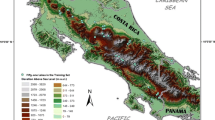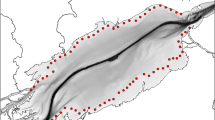Abstract
Freshwater midges, consisting of Chironomidae, Chaoboridae and Ceratopogonidae, were assessed as a biological proxy for palaeoclimate in eastern Beringia. The northwest North American training set consists of midge assemblages and data for 17 environmental variables collected from 145 lakes in Alaska, British Columbia, Yukon, Northwest Territories, and the Canadian Arctic Islands. Canonical correspondence analyses (CCA) revealed that mean July air temperature, lake depth, arctic tundra vegetation, alpine tundra vegetation, pH, dissolved organic carbon, lichen woodland vegetation and surface area contributed significantly to explaining midge distribution. Weighted averaging partial least squares (WA-PLS) was used to develop midge inference models for mean July air temperature (r 2boot = 0.818, RMSEP = 1.46°C), and transformed depth (ln (x+1); r 2boot = 0.38, and RMSEP = 0.58).
Similar content being viewed by others
References
Abbott MB, Finney BP, Edwards ME, Kelts KR (2000) Lake-level reconstructions and paleohydrology of Birch Lake, central Alaska, based on seismic reflection profiles and core transects. Quat Res 53:154–166
Barber VA, Finney BP (2000) Late Quaternary paleoclimatic reconstructions for interior Alaska based on paleolake-level data and hydrologic models. J Paleolimnol 24:29–41
Barley EM (2004) Paleoclimate analysis of southwestern Yukon Territory using subfossil chironomid remains from Antifreeze Pond. MSc thesis, Simon Fraser University, Burnaby, BC
Battarbee RW, Grytnes J-A, Thompson R, Appleby PG, Catalan J, Korhola A, Birks HJB, Heegaard E, Lami A (2002) Comparing palaeolimnological and instrumental evidence of climate change for remote mountain lakes over the last 200 years. J Paleolimnol 28:161–179
Bigelow NH, Edwards ME (2001) A 14,000 yr paleoenvironmental record from Windmill Lake, central Alaska: late glacial and Holocene vegetation in the Alaska range. Quat Sci Rev 20:203–215
Bouchard G, Gajewski K, Hamilton PB (2004) Freshwater diatom biogeography in the Canadian Arctic Archipelago. J Biogeogr 31:1955–1973
Bradley RS (1999) Paleoclimatology: reconstructing climates of the Quaternary. Academic Press, Toronto
Brodersen KP, Lindegaard C (1999) Mass occurrence and sporadic distribution of Corynocera ambigua Zetterstedt (Diptera, Chironomidae) in Danish lakes. Neo- and palaeolimnological records. J Paleolimnol 22:41–52
Brooks SJ (1999) Diagnosis of Janytarsini (June 1999)
Brooks SJ, Birks HJB (2000) Chironomid-inferred late-glacial and early-Holocene mean July air temperatures for Kråkenes Lake, western Norway. J Paleolimnol 23:77–89
Brooks SJ, Birks HJB (2001) Chironomid-inferred air temperatures from lateglacial and Holocene sites in north-west Europe: progress and problems. Quat Sci Rev 20:1723–1741
Brooks SJ, Udachin V, Williamson BJ (2005) Impact of copper smelting on lakes in the southern Ural Mountains, Russia, inferred from chironomids. J Paleolimnol 33:229–241
Cumming BF, Wilson SE, Hall RI, Smol JP (1995) Diatoms from lakes in British Columbia (Canada) and their relationship to lakewater salinity, nutrients and other limnological variables. Bibliotheca Diatomologica, J. Cramer, Stuttgart, p 207
Cwynar LC (1982) A late-Quaternary vegetation history from Hanging Lake, northern Yukon. Ecol Monogr 52:1–24
Cwynar LC, Spear RW (2001) Lateglacial climate change in the White Mountains of New Hampshire. Quat Sci Rev 20:1265–1274
Engstrom DR, Hansen BCS, Wright Jr HE (1990) A possible Younger Dryas record in southeastern Alaska. Science 250:1383–1385
Environment Canada (1994a) Manual of Analytical Methods: Major Ions and Nutrients, Vol. 1. National Laboratory for Environmental Testing, Canadian Centre for Inland Waters, Burlington, Ontario
Environment Canada (1994b) Manual of Analytical Methods: Trace Metals, Vol. 2 National Laboratory for Environmental Testing, Canadian Centre for Inland Waters, Burlington, Ontario
Gajewski K, Bouchard G, Wilson SE, Kurek J, Cwynar LC (2005) Distribution of Chironomidae (Insecta: Diptera) head capsules in recent sediments of Canadian Arctic lakes. Hydrobiologia 549:131–143
Glew J (1989) A new trigger mechanism for sediment samplers. J Paleolimnol 2:241–243
Glew J (1991) Miniature gravity corer for recovering short sediment cores. J Paleolimnol 5:285–287
Gregory-Eaves I, Smol JP, Finney BP, Edwards ME (1999) Diatom-based transfer functions for inferring past climatic and environmental changes in Alaska, USA. Arct Antarct Alp Res 31:353–365
Gregory-Eaves I, Smol JP, Finney BP, Lean DRS, Edwards ME (2000) Characteristics and variation in lakes along a north-south transect in Alaska. Arch Hydrobiol 147: 193–223
Guthrie RD (2001) Origin and causes of the mammoth steppe: a story of cloud cover, woolly mammal tooth pits, buckles, and inside-out Beringia. Quat Sci Rev 20:549–574
Heinrichs ML, Walker IR, Mathewes RW (2001) Chironomid-based paleosalinity records in southern British Columbia, Canada: a comparison of transfer functions. J Paleolimnol 26:147–159
Heiri O, Lotter AF (2001) Effect of low count sums on quantitative environmental reconstructions: an example using subfossil chironomids. J Paleolimnol 26: 343–350
Heiri O, Millet L (2005) Reconstruction of Late Glacial summer temperatures from chironomid assemblages in Lac Lautrey (Jura, France). J Quat Sci 20:33–44
Hu FS, Shemesh A (2003) A biogenic-silica δ18O record of climatic change during the last glacial–interglacial transition in southwestern Alaska. Quat. Res. 59:379–385
Hu FS, Lee BY, Kaufman DS, Yoneji S, Nelson DM, Henne PD (2002) Response of tundra ecosystem in southwestern Alaska to Younger-Dryas climatic oscillation. Global Change Biol 8:1156–1163
Hynynen J, Palomäki A, Meriläinen JJ, Witick A, Mäntykoski K (2004) Pollution history and recovery of a boreal lake exposed to a heavy bleached pulping effluent load. J Paleolimnol 32:351–374
Juggins S (2003) C2 version 1.4. University of Newcastle
Kaufman DS et al (2004) Holocene thermal maximum in the western Arctic (0–180°W). Quat Sci Rev 23:529–560
Korhola A, Olander H, Blom T (2000) Cladoceran and chironomid assemblages as quantitative indicators of water depth in subarctic Fennoscandian lakes. J Paleolimnol 24:43–54
Larocque I (2001) How many chironomid head capsules are enough? A statistical approach to determine sample size for palaeoclimatic reconstructions. Palaeogeogr Paleoclimatol Palaeoecol 172:133–142
Larocque I, Hall RI (2004) Holocene temperature estimates and chironomid community composition in the Abisko Valley, northern Sweden. Quat Sci Rev 23:2453–2465
Lotter AF, Birks HJB, Hofmann W, Marchetto A (1997) Modern diatom, cladocera, chironomid, and chrysophyte cyst assemblages as quantitative indicators for the reconstruction of past environmental conditions in the Alps. I. Climate. J Paleolimnol 18:395–420
Lotter AF, Walker IR, Brooks SJ, Hofmann W (1999) An intercontinental comparison of chironomid palaeotemperature inference models: Europe vs North America. Quat Sci Rev 18:717–735
Massaferro J, Brooks SJ (2002) Response of chironomids to Late Quaternary environmental change in Taitao Peninsula, southern Chile. J Quat Sci 17:101–111
McCulloch D, Hopkins DM (1966) Evidence for an early recent warm interval in northwestern Alaska. Geol Soc Am Bull 77:1089–1107
Natural Resources Canada (2003) Atlas of Canada. http://www.atlas.gc.ca/site/index
New M, Lister D, Hulme M, Mankin I (2002) A high resolution data set of surface climate over global land areas. Climate Res 21:1–25
Olander H, Korhola A, Blom T (1997) Surface sediment Chironomidae (Insecta: Diptera) distributions along an ecotonal transect in subarctic Fennoscandia: developing a tool for palaeotemperature reconstructions. J Paleolimnol 18:45–59
Olander H, Birks HJB, Korhola A, Blom T (1999) An expanded calibration model for inferring lakewater and air temperatures from fossil chironomid assemblages in northern Fennoscandia. Holocene 9:279–294
Oliver DR, Roussel ME (1983) The Insects and Arachnids of Canada, Part 11: The Genera of Larval Midges of Canada, Diptera: Chironomidae. Research Branch, Agriculture Canada, Ottawa
Overland JE, Wang M (2005) The Arctic climate paradox: the recent decrease of the Arctic Oscillation. Geophys Res Lett 32:1–5
Palmer SL, Walker IR, Heinrichs ML, Hebda R, Scudder G (2002) Postglacial midge community change and Holocene palaeotemperature reconstructions near treeline, southern British Columbia (Canada). J Paleolimnol 28:469–490
Phillips D (1990) The Climates of Canada. Canadian Government Publishing Centre, Environment Canada
Pienitz R, Smol JP, Birks HJB (1995) Assessment of freshwater diatoms as quantitative indicators of past climatic change in the Yukon and Northwest Territories, Canada. J Paleolimnol 13:21–49
Pienitz R, Smol JP, Lean DRS (1997) Physical and chemical limnology of 59 lakes located between the southern Yukon and the Tuktoyaktuk Peninsula, Northwest Territories (Canada). Can J Fish Aquat Sci 54:330–346
Porinchu DF, Cwynar LC (2000) The distribution of freshwater Chironomidae (Insecta:Diptera) across treeline near the Lower Lena River, Northeast Siberia, Russia. Arct Antarct Alp Res 32:429–437
Quinlan R, Smol JP (2001a) Chironomid-based inference models for estimating end-of-summer hypolimnetic oxygen from south-central Ontario lakes. Freshwat Biol 46:1529–1551
Quinlan R, Smol JP (2001b) Setting minimum head capsule abundance and taxa deletion criteria in chironomid-based inference models. J Paleolimnol 26:327–342
Ritchie JC, Cwynar LC, Spear RW (1983) Evidence from north-west Canada for an early Holocene Milankovitch thermal maximum. Nature 305:126–128
Rosenberg SM, Walker IR, Mathewes RW, Hallett DJ (2004) Midge-inferred Holocene climate history of two subalpine lakes in southern British Columbia. Holocene 14: 258–271
Rosén P, Segerstrom U, Eriksson L, Renberg I (2003) Do diatom, chironomid, and pollen records consistently infer Holocene July air temperature? A comparison using sediment cores from four alpine lakes in northern Sweden. Arct Antarct Alp Res 35:279–290
Seppälä M (2001) Unsatisfactory field data in a calibration model for inferring past temperatures from chironomid assemblages in northern Fennoscandia: a comment on Olander, Birks, Korhola and Blom. Holocene 11: 613–622
Sweetman JN, Smol JP (2006) Patterns in the distribution of cladocerans (Crustacea:Branchiopoda) in lakes across a north-south transect in Alaska, USA. Hydrobiologia 553:277–291
ter Braak CJF (1991) CANOCO version. Agricultural Mathematics Group, University of Wageningen, Wageningen, The Netherlands
ter Braak CJF (1995) Ordination. In: Jongman RHG, ter Braak CJF, van Tongeren OFR (eds) Data analysis in community and landscape ecology. Cambridge University Press, Cambridge, pp 69–173
Velle G, Brooks SJ, Birks HJB, Willassen E (2005) Chironomids as a tool for inferring Holocene climate: an assessment based on six sites in southern Scandinavia. Quat Sci Rev 24:1429–1462
Walker IR (1988) Late-Quaternary Palaeoecology of Chironomidae (Diptera:Insecta) from Lake Sediments in British Columbia. Ph.D. thesis, Simon Fraser University, Burnaby
Walker IR (1990) Modern assemblages of arctic and alpine Chironomidae as analogues for late-glacial communities. Hydrobiologia 214:223–227
Walker IR (1995) Chironomids as indicators of past environmental change. In: Armitage PD, Cranston PS, Pinder LCV (eds) The Chironomidae: Biology and Ecology of Non-biting Midges. Chapman and Hall, London, UK, pp 405–422
Walker IR (2000) The WWW Field Guide to Subfossil Midges. http://www.ouc.bc.ca/eesc/iwalker/wwwguide
Walker IR (2001) Midges: Chironomidae and related Diptera. In: Smol JP, Birks HJB, Last WM (eds) Tracking Environmental Change using Lake Sediments: Zoological Indicators. Kluwer Academic Publishers, Dordrecht, pp 43–66
Walker IR, MacDonald GM (1995) Distributions of Chironomidae (Insecta:Diptera) and other freshwater midges with respect to treeline, Northwest Territories, Canada. Arc Alp Res 27:258–263
Walker IR, Mathewes RW (1988) Late-Quaternary fossil Chironomidae (Diptera) from Hippa Lake, Queen Charlotte Islands, British Columbia, with special reference to Corynocera Zett. Can Entomol 120:739–751
Walker IR, Smol JP, Engstrom DR, Birks HJB (1991) An assessment of Chironomidae as quantitative indicators of past climatic change. Can J Fish Aquat Sci 48:975–987
Walker IR, Levesque AJ, Cwynar LC, Lotter AF (1997) An expanded surface-water palaeotemperature inference model for use with fossil midges from eastern Canada. J Paleolimnol 18:165–178
Walker IR, Levesque AJ, Pienitz R, Smol JP (2003) Freshwater midges of the Yukon and adjacent Northwest Territories: a new tool for reconstructing Beringian paleoenvironments? J N Am Benthol Soc 22:323–337
Wiederholm T (1983) Chironomidae of the Holarctic Region. Keys and Diagnoses. Part 1. Larvae. Entomologica Scandinavica, Suppl. 19
Wilson SE, Gajewski K (2004) Modern chironomid assemblages and their relationship to physical and chemical variables in southwest Yukon and northern British Columbia lakes. Arct Antarct Alp Res 36:446–455
Author information
Authors and Affiliations
Corresponding author
Rights and permissions
About this article
Cite this article
Barley, E.M., Walker, I.R., Kurek, J. et al. A northwest North American training set: distribution of freshwater midges in relation to air temperature and lake depth. J Paleolimnol 36, 295–314 (2006). https://doi.org/10.1007/s10933-006-0014-6
Received:
Accepted:
Published:
Issue Date:
DOI: https://doi.org/10.1007/s10933-006-0014-6




